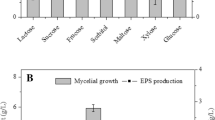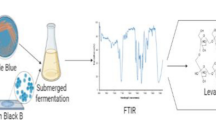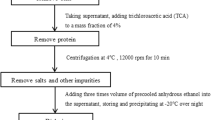Abstract
The aim of the work was to study the production of the exopolysaccharides by Agaricus brasiliensis and the isolation of exopolysaccharides (EPSs) with biological effects. A brasiliensis LPB03 was cultured in submerged fermentation in a medium containing glucose, yeast extract, hydrolyzed soybean protein, and salts (pH 6.1) at 29 °C and 120 rpm for 144 h. The maximum biomass and EPS yield was 7.80 ± 0.01 and 1,430.70 ± 26.75 mg/L, respectively. To isolate the produced EPSs, two methods were compared: (1) with alcohol precipitation and (2) treatment with tricloroacetic acid (TCA), followed by alcohol precipitation. The use of TCA facilitated the purification of the EPS, reducing the amount of the contaminant soy proteins. For monosaccharide identification, the EPSs were hydrolyzed, derivatized to alditol acetates, and analyzed by gas chromatography (GC) and GC-mass spectrometry, which showed the presence (in molar percentage) of mannose (58.7), galactose (21.4), and glucose (13.1) as major sugars, with lower amounts of rhamnose (3.9) and xylose (2.8). Scanning electron microscopy was used to observe the morphological structure of the EPS. The experiments in vivo including EPS in the mice diet during 8 weeks indicated the hipocholesteremic and hypoglycemic effects.









Similar content being viewed by others
References
Bernardshaw, S., Johnson, E., & Hetland, G. (2005). Scandinavian Journal of Immunology, 63, 393–398.
Kidd, P. M. (2000). Alternative Medicine Review, 5, 4–27.
Borschers, A. T., Keen, L. C., & Gershwin, M. E. (2004). Experimental Biology and Medicine, 229, 393–406.
Lee, Y. L., Kim, H. J., et al. (2003). Experimental Animals, 52, 371–375.
Takeda, Y., Togashi, H. J., et al. (2000). Gastroenterologia & Hepatologia, 15, 1079–1086.
Lindequist, U., Niedermeyer, T. H. J., & Jülich, W.-D. (2005). Review e CAM, 2(3), 285–299.
Wasser, S. P., & Didukh, M. Y. (2002). Int J Med Mushr, 4, 267–290.
Urben, A. F. (2005). In V Congresso Latino Americano de Micologia. Brasília, 203–205.
Itoh, H., Ito, H., & Amano, H. (1994). Japanese Journal of Pharmacology, 66, 265–271.
Adachi, Y., Suzuki, T., et al. (2002). International Journal of Medicinal Mushrooms, 4, 95–109.
Mizuno, M., Morimoto, M., et al. (1998). Bioscience Biotechnology and Biochemistry, 62(3), 434–437.
Mizuno, T., Hagiwara, T., et al. (1990). Agricultural and Biological Chemistry, 54(11), 2889–2896.
Zhang, M., & Cui, S. W. (2007). Trends in Food Science & Technology, 18, 4–19.
Soccol, C. R., & Vandenberghe, L. P. S. (2003). Biochemical Engineering Journal, 13, 205–218.
Maraschin, M. (1998). Ph.D. thesis, Federal University of Paraná, Brazil.
Ruas-Madiedo, R., & Reyes-Gavilán, C. G. (2005). American Dairy Science Association, 88, 843–856.
Yang, B. Y., Gray, J. S. S., & Montgomery, R. (1999). Carbohydrate Research, 316, 138–154.
Jodon, M. H., & Royse, D. J. (1979). Agricultural Experiment Station Bulletin, pp. 258–254.
Dalla Santa, H. S. (2006). Ph.D. thesis, Universidade federal of Paraná, Curitiba, Brazil.
Nakasone, K. K., Peterson, S. W., & Jong, S.-C. (2004). In D. Cella, & K. Sonnack (Eds.) Biodiversity of fungi. Burlington, MA: Elsevier.
Figueiredo, M. B. (2001). Biológico, January, pp. 73–82.
Fan, L. (2003), Ph.D. thesis, Universidade Federal do Paraná, Curitiba, Brazil.
Rubel, R. (2006), Ph.D. thesis, Universidade Federal do Paraná, Curitiba, Brazil.
Cuesta, G., Suarez, N., et al. (2002). Journal of Microbiological Methods, 52, 69–73.
Dubois, M., Gilles, K. A., et al. (1956). Analytical Chemistry, 28(3), 350–356.
Nelson, A. (1944). The Journal of Biological Chemistry, 153, 375–380.
Lowry, O. H., Rosebrough, N. J., et al. (1951). Journal of Biological Chemistry, 193, 265–275.
Wolfrom, M. L., & Thompson, A. (1963). Meth. Carbohydr. Chem., 2, 65–68.
Neto, C., & Oliveira, P. L. (1977). Estatistic, Edgard Blucher.
Chang, H. L., Chao, G. R., Chen, C. C., & Mau, J. L. (2001). Food Chemistry, 74, 203–207.
Stijve, T., Amazonas, M. A. A., & Giller, V. (2002). Deutsche Lebensmittel-Rundschao, 98, 448–453.
Ebina, T., & Fujimiya, Y. (1998). Biotherapy, 11, 259–265.
Ito, H., Hidaka, H., & Sugiura, M. (1997). Japanese Journal of Pharmacology, 29, 953–957.
Takaku, T., Kimura, Y., & Okuda, H. (2001). Journal of Nutrition, 131, 1409–1413.
Fan, L., Soccol, A. T., et al. (2005). LWT—Food Science and Technology, 40, 30–35.
Gern, J. C. (2006). M.Sc. dissertation, Universidade federal do Paraná, Curitiba, Brazil.
Lin, J., & Yang, S. (1996). Journal of Microbiology, Immunology and Infection, 39, 98–108.
Dong, Q., Yao, J., et al. (2002). Carbohydrate Research, 337, 1417–1421.
Blakeney, A. B., Harris, P. J., Henry, R. J., & Stone, B. A. (1983). Carbohydrate Research, 113, 291–299.
Chen, S. C., & Lu, M.-K. (2005). FEMS Microbiology Letters, 249(2), 247–54.
Jodon, M. H., & Royse, D. J. (1979). Agricultural Experiment Station Bulletin, pp. 258–254.
Mizuno, T. (1999). Int. J. Med. Mushroom, 1, 9–30.
Kim, Y. W., Kim, K. H., Chi, H. J., & Lee, D. S. (2005). Biotechnology Letters, 27, 483–487.
Lo, H.-C., Tsai, F.-A., et al. (2006). Life Sciences, 78(17), 1957–1966.
Swanson-Flatt, S. K., et al. (1989). Acta Diabetologia, 26, 51–55.
Takaku, T., Kimura, Y., & Kuda, H. (2001). Journal of Nutrition, 131, 1409–1413.
Pinheiro, F., Faria, R. R., et al. (2003). Food and Chemical Toxicology, 41, 1543–1550.
Mizuno, T., Hagiwara, T., et al. (1990). Agricultural and Biological Chemistry, 54(11), 2889–2896.
Mizuno, M. K., Minato, H., et al. (1999). Biochemistry and Molecular Biology International, 47, 707–714.
Author information
Authors and Affiliations
Corresponding author
Rights and permissions
About this article
Cite this article
Lima, L.F.O., Habu, S., Gern, J.C. et al. Production and Characterization of the Exopolysaccharides Produced by Agaricus brasiliensis in Submerged Fermentation. Appl Biochem Biotechnol 151, 283–294 (2008). https://doi.org/10.1007/s12010-008-8187-2
Received:
Accepted:
Published:
Issue Date:
DOI: https://doi.org/10.1007/s12010-008-8187-2




